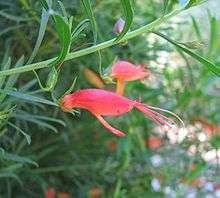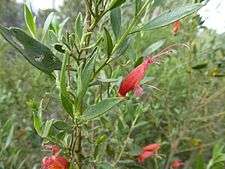Eremophila decipiens
| Slender fuchsia | |
|---|---|
 | |
| E. decipiens in Geelong Botanic Gardens | |
| Scientific classification | |
| Kingdom: | Plantae |
| (unranked): | Angiosperms |
| (unranked): | Eudicots |
| (unranked): | Asterids |
| Order: | Lamiales |
| Family: | Scrophulariaceae |
| Genus: | Eremophila |
| Species: | E. decipiens |
| Binomial name | |
| Eremophila decipiens Ostenf.[1] | |
| Synonyms | |
|
Eremophila maculata var. linearifolia S.Moore | |
Eremophila decipiens, commonly known as slender fuchsia bush or narrow-leaved fuchsia bush (although it is not closely related to Fuchsia) is a flowering plant in the figwort family, Scrophulariaceae and is endemic to an area extending from the south-west of Western Australia to southern parts of South Australia. It is low, sprawling shrub with lance-shaped leaves and red, orange or yellow flowers on a long, S-shaped stalk.
Description
Eremophila decipiens is a low, sprawling shrub with many tangled branches growing to a height of between 0.3 and 1.0 m (1 and 3 ft). The ends of the branches and the leaves are sticky and shiny due to the presence of resin. The leaves are arranged alternately, sometimes densely clustered, sometimes scattered along the stems. They are glabrous, linear to lance-shaped, sometimes with a few irregular teeth on the margins, mostly 15–46 mm (0.6–2 in) long and 1.5–9 mm (0.06–0.4 in) wide.[2][3][4]
The flowers are borne singly in leaf axils on a S-shaped stalk 11–22 mm (0.4–0.9 in) long and at least twice as long as the longest sepal. There are 5 egg-shaped to triangular, slightly overlapping sepals mostly 3–6 mm (0.1–0.2 in) long which are slightly hairy and sticky. The petals are 15–30 mm (0.6–1 in) long and joined at their lower end to form a tube. The petal tube is red, orange or sometimes yellow and lacks spots. The outer surface of the petal tube and lobes are usually glabrous, often sticky while the inside is covered with short hairs. The 4 stamens extend beyond the end of the tube. Flowering occurs from February to December,[2][3][4] although in the Esperance region mostly between July and November.[5] The fruits are dry, cylinder-shaped to almost spherical, glabrous with a papery covering and are 4–7.5 millimetres (0.2–0.3 in) long.[2][3][4]
.jpg)

E. decipiens is sometimes mistaken for Eremophila glabra but the latter species lacks a long, S-shaped flower stalk.[6]
Taxonomy
The species was first formally described in 1921 by Carl Hansen Ostenfeld in Biologiske meddelelser, Kongelige Danske Videnskabernes Selskab.[1] The specific epithet (decipiens) is a Latin word meaning "deceiving", "trapping" or "cheating"[7] referring to the similarity of this species to Eremophila maculata.[3]
There are two subspecies:
- Eremophila decipiens Ostenf. subsp. decipiens[8] which has leaves that are wider than 2 millimetres (0.08 in) and petals that are glabrous on the outside;
- Eremophila decipiens subsp. linearifolia (Moore) Chinnock[9] which has leaves that are narrower than 2 millimetres (0.08 in) and petals that have glandular hairs on the outside.[2][3]
Eremophila decipiens subsp. linearifolia was first formally described as Eremophila maculata var. linearifolia in 1920 by Spencer Le Marchant Moore.[10] It is much less common than subspecies decipiens.[3]
Distribution and habitat
Eremophila decipiens subsp. decipiens occurs throughout the south-west botanical province but also extends north to Wiluna and east across the Nullarbor Plain to the Eyre Peninsula in South Australia. Subspecies linearifolia has a more restricted distribution in the eastern wheatbelt and goldfields. Both subspecies grow in a variety of soil types often in Eucalyptus woodland.[2][3][5][11][12]
Ecology
Most species of Eremophila are insect pollinated[13] - E.decipiens is one of the 40 or so that are pollinated by birds.[5]
Conservation
Eremophila decipiens is classified as "not threatened" by the Government of Western Australia Department of Parks and Wildlife.[11]
Use in horticulture
Slender fuchsia bush is a hardy garden plant which will grow in most soils in full sun or partial shade and will tolerate harsh drought conditions or severe frosts. Propagation is very difficult from seed but cuttings strike readily when mist is not used. It is long-lived in the garden and some specimens are more than 30 years old. Older specimens respond well to even heavy pruning.[6][14]
References
- 1 2 "Eremophila decipiens". APNI. Retrieved 5 January 2016.
- 1 2 3 4 5 Chinnock, R.J. (Bob) (2007). Eremophila and allied genera : a monograph of the plant family Myoporaceae (1st ed.). Dural, NSW: Rosenberg. pp. 593–597. ISBN 9781877058165.
- 1 2 3 4 5 6 7 Brown, Andrew; Buirchell, Bevan (2011). A field guide to the eremophilas of Western Australia (1st ed.). Hamilton Hill, W.A.: Simon Nevill Publications. pp. 75–76. ISBN 9780980348156.
- 1 2 3 "Eremophila decipiens". Electronic Flora of South Australia. Retrieved 5 January 2016.
- 1 2 3 Archer, William. "Eremophila decipiens". Esperance Wildflowers. Retrieved 5 January 2016.
- 1 2 Boschen, Norma; Goods, Maree; Wait, Russell (2008). Australia's eremophilas : changing gardens for a changing climate. Melbourne: Bloomings Books. pp. 83–84. ISBN 9781876473655.
- ↑ Brown, Roland Wilbur (1956). The Composition of Scientific Words. Washington, D.C.: Smithsonian Institution Press. p. 476.
- ↑ "Eremophila decipiens subsp. decipiens". APNI. Retrieved 5 January 2016.
- ↑ "Eremophila decipiens subsp. linearifolia". APNI. Retrieved 5 January 2016.
- ↑ "Eremophila maculata subsp. linearifolia". APNI. Retrieved 6 January 2016.
- 1 2 "Eremophila decipiens". FloraBase. Western Australian Government Department of Parks and Wildlife.
- ↑ Paczkowska, Grazyna; Chapman, Alex R. (2000). The Western Australian flora : a descriptive catalogue. Perth: Wildflower Society of Western Australia. p. 334. ISBN 0646402439.
- ↑ Chinnock, Robert J. (2007). Eremophila and allied genera : a monograph of the plant family Myoporaceae (1 ed.). Dural, NSW: Rosenberg. p. 50. ISBN 9781877058165.
- ↑ Wrigley, John W.; Fagg, Murray (1983). Australian native plants : a manual for their propagation, cultivation and use in landscaping (2nd ed.). Sydney: Collins. p. 212213. ISBN 0002165759.